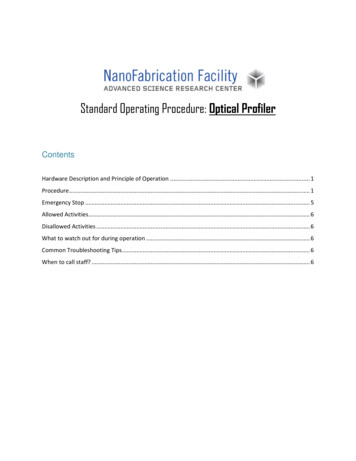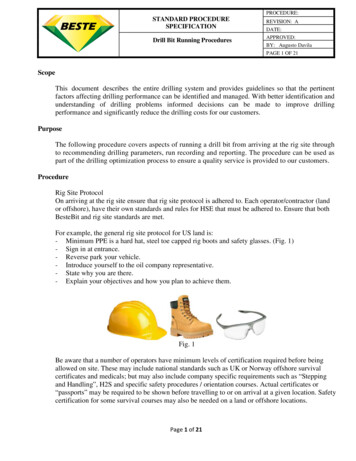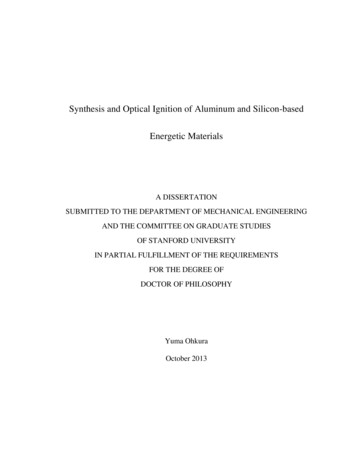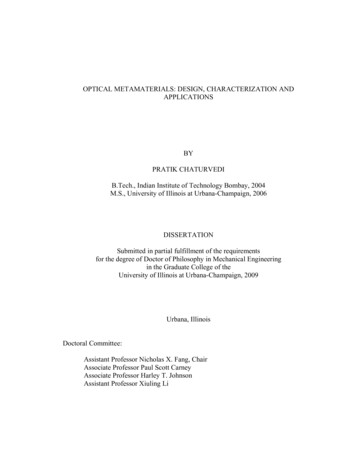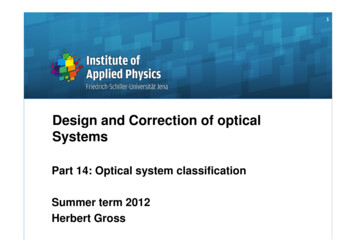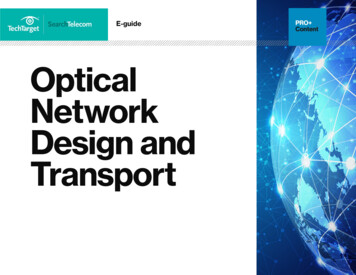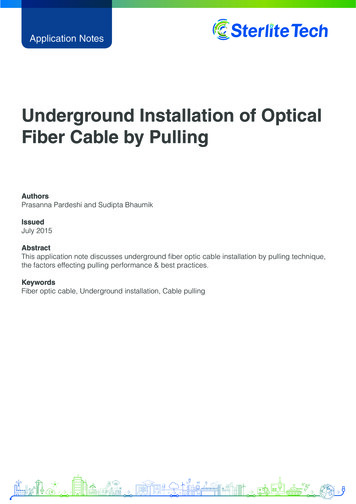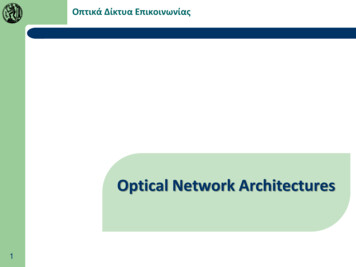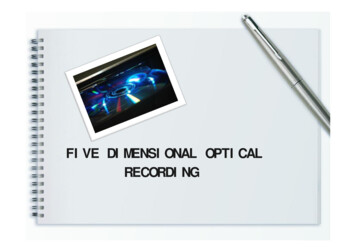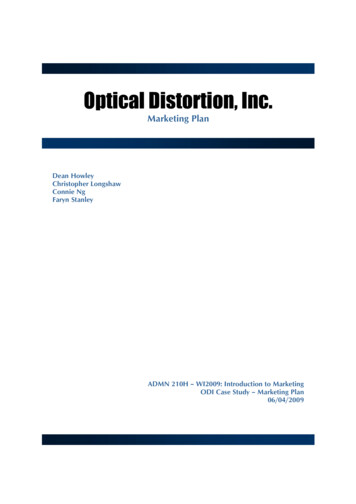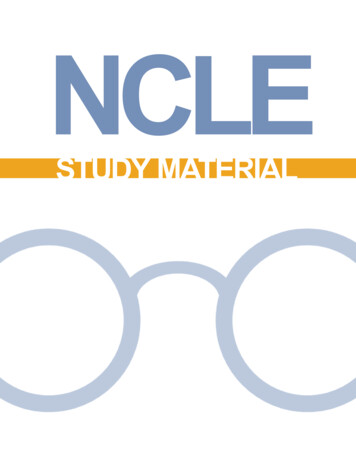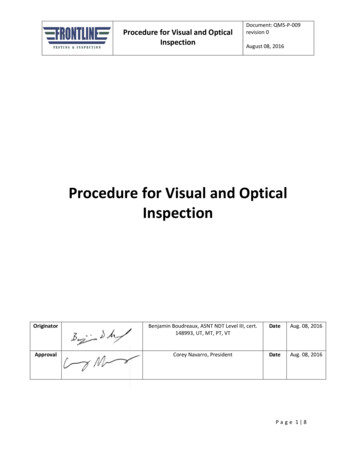
Transcription
Procedure for Visual and OpticalInspectionDocument: QMS-P-009revision 0August 08, 2016Procedure for Visual and OpticalInspectionOriginatorBenjamin Boudreaux, ASNT NDT Level III, cert.148993, UT, MT, PT, VTDateAug. 08, 2016ApprovalCorey Navarro, PresidentDateAug. 08, 2016P a g e 1 8
Procedure for Visual and OpticalInspectionDocument: QMS-P-009revision 0August 08, 2016Revision HistoryRevision levelOriginalDescription of RevisionsProcedure for Visual and Optical Inspection was createdDate8-08-2016P a g e 2 8
Procedure for Visual and OpticalInspectionDocument: QMS-P-009revision 0August 08, 20161. Scope1.1 This procedure describes the visual examination that may be performed on any number of items orcomponents such as structural welds, tools, threaded connections, castings, forgings or other machinedparts.1.2 This procedure may be applied to the standard practices set forth in TH Hill’s DS-1 Volume 3 latest edition.1.3 This procedure may also be applied to the requirements set forth in AWS D1.1 structural weld inspection forboth tubular and non-tubular inspection as well as API 6A requirements.2. Referenced Documents2.1 TH Hill DS-1 Volume 3 – Drill Stem Inspection, latest edition2.2 AWS D1.1 – Structural Welding Code-Steel, latest edition2.3 ASME Section V, Article 9 – Visual Inspection, latest edition2.4 API 6A/ ISO 10423 – Specification for Wellhead and Christmas Tree Equipment, latest edition2.5 ASNT SNT-TC-1A – Recommended Practice for the Qualification and Certification of NDT Personnel, latestedition2.6 If contract requirements specify reference documents other than the latest edition Frontline Testing andInspection’s Management will ensure that all details of this procedure still comply. In the event that noncompliance is found this procedure shall be revised or a project specific procedure shall be written.3. Personnel Qualification3.1 Personnel performing inspections to this procedure shall be qualified and certified in accordance with ASNTSNT-TC-1A latest edition and Frontline Testing and Inspection’s procedure for the qualification andcertification of personnel.3.2 Only those personnel, certified Level II or higher in the method being employed, are allowed to performinspections in accordance with this procedure.3.3 For weld inspection, current AWS CWI certification meets the personnel qualification requirements of thisprocedure.4. Techniques4.1 Direct inspectionWhen direct inspection is employed it shall be performed when access is sufficient to place the eye within24” of the surface to be examined and at an angle not less than 30 to the surface to be examined.Mirrors shall be used, when deemed necessary to improve the angle of vision, and aids such as amagnifying lens may be used to assist examinations.P a g e 3 8
Procedure for Visual and OpticalInspectionDocument: QMS-P-009revision 0August 08, 20164.2 Remote inspectionWhen conducting remote inspection the use of visual aids such as telescopes, bore scopes, fiber scopes,cameras, or other suitable instruments shall be used. Such systems shall have a resolution capability atleast equivalent to that obtainable by direct visual observation.5. Equipment Requirements5.1 The following is a list of standard required equipment for direct visual inspection.5.1.1 6” long, 1/64” graduated, rule5.1.2 Flash light or other adequate light source5.1.3 Rags, scrapper or other suitable cleaning apparatus as applicable5.1.4 Mirror5.1.5 Dial calipers (if applicable)5.1.6 Pit gauge (if applicable)5.1.7 Thread gauge (if applicable)5.1.8 Fillet weld gauges or other suitable and applicable weld gauge5.1.9 Light meter (only if not in obviously acceptable light, i.e. sunlight)5.2 The following is a list of standard required equipment for remote visual inspection. The owner’s manualshall be followed for proper use of any scopes, if employed.5.2.1 Telescope (if applicable)5.2.2 Bore scope (if applicable)5.2.3 Fiber scope (if applicable)5.2.4 Camera (if applicable)5.2.5 Flashlight or other adequate light source5.2.6 Light meter (only if not in obviously acceptable light, i.e. sunlight)5.3 Minimum light levelAt the inspection surface, the minimum light level shall be at least 1000 Lux (100 foot-candles). A lightmeter shall be used that is within its re-calibration interval.P a g e 4 8
Procedure for Visual and OpticalInspectionDocument: QMS-P-009revision 0August 08, 20165.3.1 In the event inspection is to be performed in under obviously acceptable lighting then theemployment of the light meter may not be necessary. Sunlight and/or most typical 60wattincandescent light bulbs will put out enough illumination so as to exceed 1000lux (100 foot-candles).5.3.2 Artificial light may be used anytime it is deemed necessary by the NDT Level II. Flashlights, drop lightsor any other similar form of light may be used.5.4 Cleaning equipment, as deemed necessary, shall be used. This may be rags, solvents, buffers, wire brushesor scrappers.5.5 Calibration requirements for testing and inspection equipment shall be as deemed in Frontline Testing andInspection’s Quality Management System. Of the equipment listed in this procedure, the following shall becalibrated or have calibration verification performed every 6 months.5.5.1 Light meter5.5.2 Scopes5.5.3 Thread gauges5.5.4 Pit gauge5.5.5 Dial calipers5.6 The following gauges shall be certified and have supporting documentation of such certification by themanufacturer.5.6.1 Fillet weld/ weld gauges6. Preparation6.1 It shall be determined that the light source is adequate to produce the desired luminance across the entirearea or weld surface to be inspected.6.2 Parts, areas, welds or threads shall be cleaned to the degree that all dirt, paint, scale, weld spatter, grease,oil, slag or any other foreign debris is removed so as to allow for a complete visual inspection. Surfacesbeing prepared for inspection shall include all areas of interest as well as 1” of the adjacent area of the partor weld.6.3 If sand blasting or other more extreme means of cleaning is required the client will be notified andarrangements made.7. Process7.1 Direct Visual Inspection7.1.1 Surfaces to be inspected shall include 1” of the adjacent surface.P a g e 5 8
Procedure for Visual and OpticalInspectionDocument: QMS-P-009revision 0August 08, 20167.1.1.1 For weld inspection this is to include 1” of the adjacent parent material measured fromeither toe of the weld so as to include the HAZ.7.1.1.2 For threaded connections, unless otherwise specified, the entire connection shall beinspected including 1” of the adjacent material measured from the shoulder or final thread,depending on thread type.7.1.2 Mirrors may be used as needed.7.1.3 The entire area of interest shall be visually inspected including the 1” of the adjacent areas. Thegoverning code shall be referenced for specific details of what to look for.7.1.4 The applicable gauges shall be used to determine dimensions of anomalies if any.7.1.5 Articulation of the light, mirror or any other device being employed to assist in the inspection shall bemade to avoid shadows.7.2 Remote Visual Inspection7.2.1 If employing any type of bore scope or fiber scope you must determine the level of magnification, ifany, prior to starting the inspection.7.2.2 The inspector shall be thoroughly familiar with the standard operation of the scope as specified in theowner’s manual.7.2.3 Surfaces to be inspected shall include 1” of the adjacent surface.7.2.3.1 For weld inspection this is to include 1” of the adjacent parent material measured fromeither toe of the weld so as to include the HAZ.7.2.3.2 For threaded connections unless otherwise specified the entire connection shall be inspectedincluding 1” of the adjacent material measured from the shoulder or final thread dependingon thread type.7.2.4 The entire area of interest shall be visually inspected including 1” of the adjacent areas. Thegoverning code shall be referenced for specific details of what to look for.7.2.5 The applicable gauges shall be used to determine dimensions of anomalies if any.7.2.6 Articulation of the light, mirror or any other device being employed to assist in the inspection shall bemade to avoid shadows.8. Evaluation and Acceptance Criteria8.1 All discontinuities found shall be evaluated in accordance with the applicable code or specification asdictated by the client. In most all instances, cracks are prohibited and shall be brought to the attention ofthe client or client representative immediately.8.2 Definitions applicable to weld inspectionP a g e 6 8
Procedure for Visual and OpticalInspectionDocument: QMS-P-009revision 0August 08, 20168.2.1 Lack of Penetration – Failure of the filler metal and base metal or the base metal alone if no fillermetal is used, to fuse integrally at the root of the weld to the depth required in the WPS8.2.2 Lack of Fusion – Failure to fuse together adjacent layers of weld metal or weld metal and base metal8.2.3 Undercut – Melting away of the side wall of a welding groove at the edge of a layer or bead or areduction in the base metal thickness at the fusion line8.2.4 Visible Porosity – Gas pockets or voids free of any solid material; pores may be individual, clusteredand/ or aligned/ linear8.2.5 Overlap – Condition in which the weld metal protrudes beyond the boundary dictated by the WPS;normally seen at the weld toe8.2.6 Linear discontinuities – May be cracks or non-fusion; may be found anywhere in the area of interest8.2.7 Under-fill – Depression on the face of the weld surface extending below the surface of the adjacentbase metal8.2.8 Improper weld size – Excessive or insufficient width of weld surface8.2.9 Concave weld and Convex weld –8.2.10 Arc strike – Discontinuity left on surface of base metal where the arc-welding electrode hasmomentarily touched the base metal8.3 Weld Appearance8.3.1 Uniformity of weld ripple, variation in width of surface layer, depressions, reinforcement height8.3.2 Spatter – Metal particles expelled during welding which are attached to but do not form a part ofeither the weld or parent metal8.3.3 Crater – Depression at the termination of a bead or in the weld pool beneath the electrodeP a g e 7 8
Procedure for Visual and OpticalInspectionDocument: QMS-P-009revision 0August 08, 20168.3.4 Profile – Contour of a fillet weld face8.3.5 Misalignment – Failure to properly align abutting parts to be joined by butt welds8.3.6 Excessive reinforcement – Weld metal in excess of the quantity required to fill a joint8.4 The client is ultimately responsible for dictating the applicable acceptance criteria.9. Reporting9.1 All rejected findings shall be reported to the client or client representative immediately.9.2 Frontline Testing and Inspection personnel will produce a report at the end of each job with the followingminimum information.9.2.1 Name of inspector (printed and signed)9.2.2 Certification level and method of inspector9.2.3 Date of inspection9.2.4 Location of inspection9.2.5 Description and traceability of test specimens9.2.6 Results of inspection (acceptable or rejected) including applicable tolerances9.2.7 Inspection procedure number including revision level9.2.8 Acceptance criteria including revision level9.2.9 Test equipment serial number and calibration due date (if applicable)9.2.10 Light intensity9.2.11 Customer name9.2.12 Customer project name, if applicable9.2.13 Customer PO or job number, if applicable9.2.14 Drawing number and revision, if applicable9.2.15 Inspection report number9.2.16 Client representative name and date (if applicable)P a g e 8 8
1.3 This procedure may also be applied to the requirements set forth in AWS D1.1 structural weld inspection for both tubular and non-tubular inspection as well as API 6A requirements. 2. Referenced Documents : 2.1 TH Hill DS-1 Volume 3 – Drill Stem Inspection, latest edition : 2.2 AWS D1.1 – Structural Welding Code-Steel, latest edition : 2.3 ASME Section V, Article 9 – Visual Inspection .File Size: 288KBPage Count: 8
